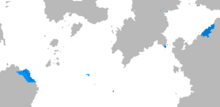Dhimze language
| Dhimze | |
|---|---|
| Jmidzi | |
| Pronunciation | [ˈd͡ʒmid͡zi] |
| Native to | Dhimrai |
| Ethnicity | Dhimze people |
Native speakers | X |
Yasgan
| |
Early forms | Common Dhimze
|
| Yasgan alphabet | |
| Official status | |
Official language in | |
Recognised minority language in | |
 Areas where Dhimze is the majority language (medium blue) or a minority language (light blue) | |
Dhimze (jmidzi [ˈd͡ʒmid͡zi]) is a Dhimzic language of the Yasgan family. It descended from Common Dhimze, which was the lingua franca of the ancient Dhimze civilisation. Most of its closest relatives from the Dhimzic family are now long extinct, with the exception of Gharzi, which also descended from Common Dhimze. Throughout its history, Dhimze has been a prestige language in Yazland and other regions, but its use as a scientific and artistic language has faded out since the end of the Copper War.
An attempt to preserve Dhimze has been made in Neo-Dhimze, a revival attempt of Common Dhimze with modernised pronounciation. Neo-Dhimze was primarily for use by the nobility and was later adopted by conservative writers and journalists. In 4550 CY, roughly 19% of the population claimed to have some understanding of Neo-Dhimze, and by 4610 CY only about 4% claim to speak it to some degree.
Dhimze is spoken across the Dhimze colonial empire, which spans several continents from Huo to Ashnan. In Dhimze proper, approximately 83% of the population speaks Dhimze as their first language, and in total 94% claim to be fluent. In New Dhimze, approximately 42% of the population speaks Dhimze as their first language, and in total 51% consider themselves fluent.